Distant Worlds 2 review: a troubled but brilliant 4X that sets its own terms
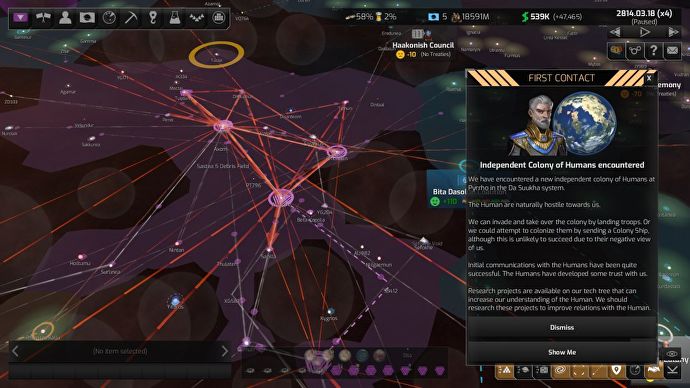
Do you ever find yourself explaining how best to approach a game, but still failing to take that approach yourself, and getting frustrated with it?
After spending far, far too long trying to obsessively control every detail of Distant Worlds 2, I’ve accepted that I need to take my own advice and work with its macromanagement systems instead. They are, after all, the reason its ludicrous scale is workable at all beyond the opening hours, and a major reason its predecessor was so interesting and forward-thinking to begin with. But they are also a source of great friction and confusion, especially if you don’t take the time to learn how they actually work.
Distant Worlds 2 is, ultimately, a game that you need to meet in the middle. Consequently, it’s one that I can only partially recommend. But I really do recommend it for that part.
Distant Worlds 2 is a vast 4X built around a logistical simulation in which “private economy” ships beyond your direct control mine and transport resources, which you use as the state to expand and protect infrastructure, and settle new planets. Its scale and complexity give rise to a system of automation settings that allow you to delegate any tasks you don’t have interest or time for. Despite knowing all this from my time with the original, it’s taken me far too long to internalize it.
I owe you all an apology, in fact. I’ve been stymied with this one, and (despite having delivered this review in two parts) frankly still want to play it some more, maybe starting over again, to really wring it out. That in itself gives us a positive angle to start with, at least. This is a game large and complex enough that there’s plenty to get stuck into, and more often than not, its frustrations had me thinking of solutions. Things going wrong tend to mean you’ve misunderstood something, or neglected to organize part of your space empire properly. But too often, in its present state, its problems are things only its developers can fix.
This is a game large and complex enough that there’s plenty to get stuck into, and more often than not, its frustrations had me thinking of solutions.
For the record, I’ve apparently been lucky. I’ve had a handful of crashes, which I can forgive across two solid weeks of play, but judging by player feedback crashes have been a much more common occurrence for a fair few players. Codeforce have been patching issues steadily since release, and there’s little doubt that much will continue. I certainly hope that those are corrected, and that subsequent patches come to address the plethora of niggling complaints you’ll have even if you love it like I do.
Above all, there isn’t enough clarity in where your money’s actually coming from. Finding out which resources you’re importing and exporting is incredibly vague for a game with such an emphasis on supply and demand, and I’ll often find that a colony’s income shifts dramatically for a while without explanation. Even when you understand its principles, the detail of how your economy is doing is still a black box, and understanding why things are happening involves too much guesswork.

The notifications in particular need work. There are tools to filter messages, but they’re all or nothing. Say you’re getting tired of endless messages telling you that some alien colony you’ve never heard of had an outbreak of a virus you can do nothing about. Your options are to block all messages about affected empires, or to block all galactic news, both of which will leave you in the dark about things that matter. Other messages are devoid of context – if I told you right now that the colonists at Braka 2 sighted a sea beast, what would you make of that? Because I have no more ideas than you do where Braka 2 even is. Braka 2 doesn’t exist, in fact. I just stopped paying attention to most place names hundreds of messages ago.
Finding things can be a chore. There are no search options for DW2’s hundreds of planets. Your ship design screens can tell you how many of every model you have, but if you want to find those three obsolete carriers, you’ll have to track them down manually somehow. That’s made more difficult by the way a fleet is displayed; select a ship and a panel in the bottom left lists lots of details about it. Select more than one, however, and that’s all replaced with one tiny icon per ship, most of which look very similar, and tell you nothing even when hovered over.
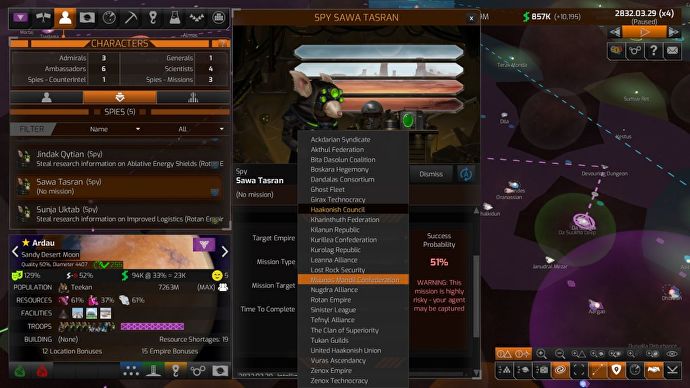
DW2 introduces subdivisions of each ship class – where there once were frigates, say, there’s now the potential to research multiple types of frigates for different purposes – but each type still looks identical, and not even the detailed selection panel lists its subtype. Worse still, the ship design and upgrade system, powerful as it is, assumes you want only one type of frigate, one of escort, one carrier, etc. Attempting to build a navy with more than one model in each class gets the refitting AI hopelessly confused, necessitating loads of annoying micromanagement.
You can set up a fleet template with whatever balance of hull types you like… except that those subtypes aren’t accounted for, so your three distinct destroyer designs for different purposes are all replaced with whichever one you updated last. Even when you’ve done that, those fleet templates are never updated, so when you use the almost excellent single-click “build fleet” option, your yards build a batch of obsolete ships that you then have to track down and refit individually.
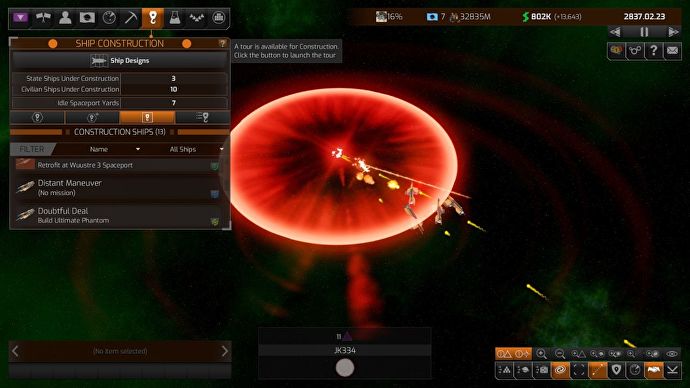
The dynamic icons at the bottom of the screen, meanwhile, are too dynamic. Zoom into a star system and any planets and starbases there appear at the bottom, which is great. But if you then zoom out to the galaxy level, they’re replaced with your most important colonies, shipyards, and fleets (the icons for which all look identical). Which sounds great, until you realize that 95% of the time, you’re zooming in to a location to send a fleet there from somewhere else. So you have to manually find your target by panning and zooming into it, then zoom out to select the fleet, assign them a hotkey (in the classic RTS “ctrl + 1” style), then find the target again, zoom in to it again, add that as another number, etc, etc.
You see what I mean? It takes hundreds of words to demonstrate problems that are relatively minor, but add up to a lot of unnecessary friction.
And yet I stop short of characterizing Distant Worlds 2 as frustrating because the sum of these annoyances still isn’t enough to outweigh the fun I have with it, and the excitement it still generates when things are going right.
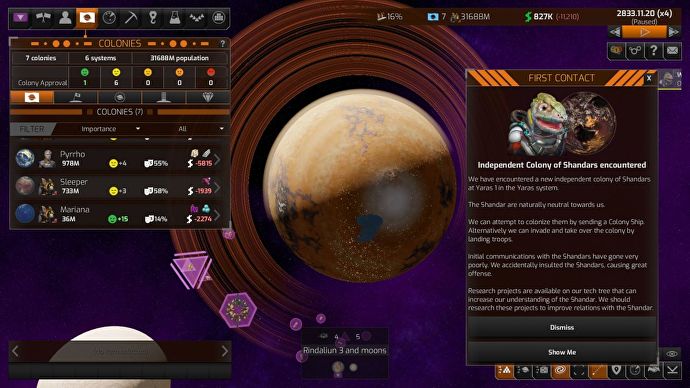
Here’s an example. In a typical 4X, you have to tediously shove armies around a map for hours any time a neighbor starts a fight. In Distant Worlds 2, you can instead set up templates for how a fleet behaves, order that type of fleet built automatically at whichever shipyards are free, and have them on standby so that you can later designate a target and know that one of those fleets will deal with it when they’re free. In between hours of manually tracking down space monsters and outfitting and supervising fleets, I’d been building occasional pairs and trios of cheap ships and setting their AI to “auto-escort”. A few hours later, I found myself with a gang of new ships I didn’t recognize, with components more advanced than my designs. My cheap little spare ships, you see, had been following civilian miners and freighters through dangerous shipping zones, and because I’d given them assault pods, they’d been boarding and capturing pirate vessels completely independently, in a region of the galaxy I ‘d yet to even look at.
Having forgotten what I was doing with some other ships, I shrugged and set them all to automatically attack targets of opportunity. When a threat appeared much later in an outlying system, I impatiently panned to it, expecting I’d have to pull my fleets away from my elaborate plans, only to watch as about 20 of my destroyers and a few carriers independently warped onto the enemy ships and gate them apart.
The tools are there, is the thing. Sometimes they don’t do what they’re supposed to, but the far bigger problem is that they’re only effective if you set them up right, and DW2 does a poor job of helping you with that. It’s easy to say Distant Worlds is a game where you can automate everything or control everything, but it’s at its best when you hew to neither extreme. The idea isn’t to have the game play itself, but to give guidelines for the AI. So many frustrations come from not knowing how far to trust the automation because it just doesn’t tell you.
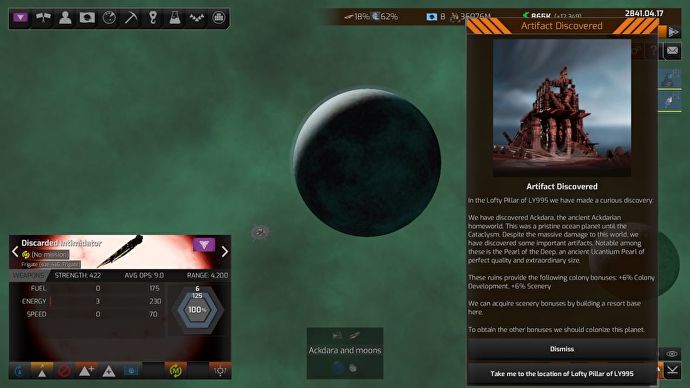
The private economy is a clue, really. Even the mining guild government, with its direct control of mining ships, is basically irrelevant because your empire becomes too big to ferry about a single mining ship almost immediately. It gets frustrating in the details when you try to control them all because you’re not supposed to. Efficiency is not how a big organization works (and nor should it, because humans aren’t actually machines, and anything that serves us shouldn’t be either, but that’s a whole other subject), and while you can control a fledgling empire, you need to let it go over time.
I failed to do this for ages because I hate taking losses. I hate waste. But you need to accept them. Your fleet of 15,000 strength might struggle against one of 13,000 strength because your pilots were idiots. But rather than micromanage the fight, you should build redundancy into the system. High level solutions to compensate for low level shortcomings. And the more you do so, the more gratifying it becomes. A prompt asking for your permission for a patrol fleet to investigate a dangerous area is honestly much more fun than panning around the map looking for it yourself. Sure, that sounds like trouble. Good idea, assistants! I permit an investigation.
This is what leadership is, sometimes. It’s not coming up with all the ideas yourself, it’s evaluating them. The very first thing I wrote for RPS was about King Of Dragon Pass and the fantasy of people coming to you asking for decisions. DW2 is about that, too. You can control everything, but outside the early stages, you shouldn’t. It’s better to prioritize, to focus on what you want to set up right now. Perhaps it’s that new colony in the nebula. Perhaps it’s time you reorganized your home fleet composition. Perhaps you’re concerned the Boskara will invade, so it’s time to fix your sensor network.
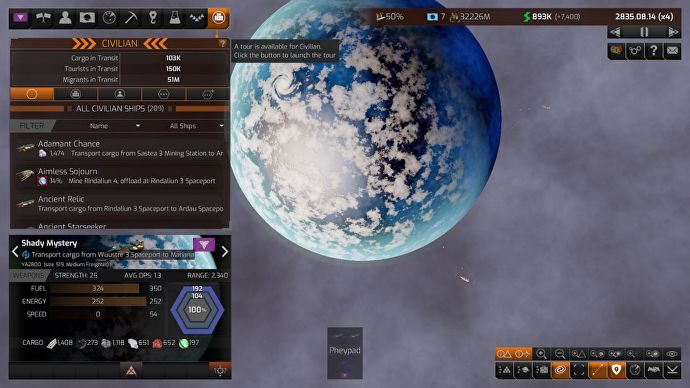
It’s better to be the roving administrator who goes from office to office as needed, not the dictator who refuses to let anything happen unless it was their idea. And that’s actually a really interesting solution to that longstanding problem of the 4X, where the fun early game morphs into a plodding, inexorable chore of build orders and lacing up every soldier’s boots. Why should you deal with that? You can, but it’s better to supervise a little, then step back. The little pioneer must become a governor, then an emperor, and must leave pioneerish things behind.
Distant Worlds 2 has a lot of potential, both for official improvements and expansions and for mods, which is no small thing, but it’s tangential to how it stands up on its own merits. And on that basis… it needs another draft, but I’m still enjoying it. It has a few months of patching and tweaking and rebalancing in store, even if you discount those performance issues. If you were hoping for a revolution, it isn’t here. But it is a considerably improved update of Distant Worlds, and frankly has no direct competition. I want it to succeed, and while I can neither condemn nor wholeheartedly recommend it, I definitely think it’s worth meeting in the middle.
Reference-www.rockpapershotgun.com